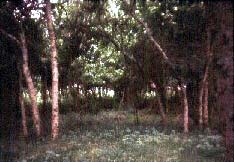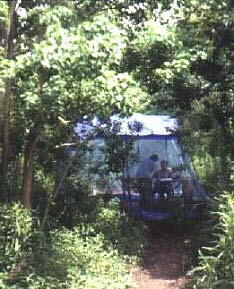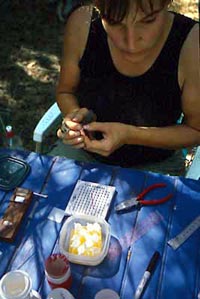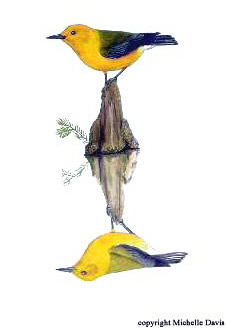| |
SITE DESCRIPTION
 |
This site is a
privately owned woodland close to the town of Johnson
Bayou. The habitat is characterized by narrow strips
of woodland dominated by hackberry (Celtis laevigata)
and other tree species, including, in order of abundance,
red mulberry (Morus rubra), live oak (Quercus
virginiana), honeylocust (Gleditsia triacanthos),
Japanese honeysuckle (Lonicera japonica) and
tallowtree (Sapium sebiferum). Understory
species include yaupon (Ilex vomitoria), blackberry
(Rubus L.sp.), greenbrier (Smilax tamnoides),
poison ivy (Toxicodendron radicans), and cherokee
rose (Rosa laevigata). Cattle grazing is common
among the cheniers, leaving sparse understory and a
simple vertical vegetative structure.
|
RESEARCH ACTIVITY
We've been working here
since 1993. During the
field season, approxiamately 25 "high" and
"low" mist-nets are operated daily at the
site, weather permitting. We capture about 1,900
birds per season with an average effort of about 7000
net hours. Over nine seasons of operation, 115
species of birds have been captured.
Click
here for a complete table
of all the birds captured at the Johnson Bayou study
site over the years.
We have also
collected blood samples, feathers, fecal samples,
and data on vegetation, arthropod abundance,
and weather during some years.
|
 |
JENNIFER OWEN
 |
The
main focus of Jen's research was to assess the immunocompetence
of landbird migrants during spring passage. In particular,
She was interested in whether birds trade-off immune
function in response to the heightened demands of
the migratory period. During migration a migrant
is faced with many challenges en route, including
variation in quality and availability of food, unfamiliarity
with stopover habitat, predation risk, adverse weather,
competition for resources, and novel parasite fauna.
In anticipation of the energetic demands of migration,
birds become hyperphagic, consuming food at an increased
rate. In other vertebrates, evidence exists
that increased activity, food deprivation, malnutrition,
and sleep deficit result in depressed immune function.
Trans-Gulf migration provides the ideal opportunity
in which to study the effect of prolonged, strenuous
exercise on the avian immune system.
The
focal species of her research were Swainson's Thrush
(Catharus ustulatus), Wood Thrush (Hycochilia mustelina),
Veery (Catharus fuscescens), Gray-cheeked
Thrush (Catharus minimus), and Ovenbird
(Seirus seirus). |
For
each focal species captured, blood were drawn via the brachial
vein (see techniques)and collected in several 75mm heparanized
capillary tubes. A blood smear was made, fixed in
100% methyl alcohol and stained using a Giemsa/Wright combination
stain. The blood was spun in a microhematocrit centrifuge.
From the blood samples, she assayed hematocrit, white blood
cell counts (absolute and differential), sedimentation
rate, and IgG.
Several
aviary experiments were conducted looking at nocturnal
restlessness and immunocompetence. Birds were held
in individual cages within an indoor aviary. Each cage
was equipped with two horizontal perches attached to microswitches
which record hopping activity via a data logger. In addition
to the hematological parameters mentioned above, we used
a phytohemaggluttin (PHA) immune challenge test to assess
the competence of the cell-mediated branch of the immune
system.
The
laboratory component of the project was located at the
University of Southern Mississippi immunology lab under
the direction
of Dr. Bobby Middlebrooks and Dr. Rhonda Patterson. We
have purified Swainson's Thrush IgG from eggs collected
in both MI (courtesy of Robert J. Smith) and VT (courtesy
of Kent McFarland, VINS). The purified IgG was used
to produce antiserum whichis being used in ELISAs to assess
concentration levels of IgG of individual birds.
The
University of Southern Mississippi. Last modified:
24 February, 2007
.
Questions and
Comments?
URL: http://www.usm.edu/mbrg/job.html
AA/EOE/ADAI |
